Kristen takes us through some choice ways to plunder your opponent’s graveyards.
Recursion is something I’ve enjoyed writing about before over at Hipsters of the Coast. I feel that, along with ramp and draw, recursion is one the pillars of the Commander format — especially when it comes to gauging power levels.
The Power of Recursion
In fact, one of the easiest ways to de-power a deck is to cut the recursion. I’ve done this many times, and it’s as easy as dropping Regrowth and Eternal Witness in green, or Sun Titan in white. We play a singleton format, and part of what makes games exciting at more casual levels of play is seeing more of our opponents’ decks. Casting the same spell over and over is powerful, but we love variety, right?
Today, I’m going to go over some of my favorite ways to use your opponent’s graveyard. The power of recursion is often in replaying your own best cards, but you shouldn’t ignore the potential opportunities across the table. Not only is playing your opponent’s cards powerful, but it can also be a lot of fun, and it can lead to some really fun stories.

I can still remember the time an opponent’s extra turn spell enabled me to close a game earlier than I thought I could in my Golos flicker deck. I hadn’t yet drawn into my Peregrine Drake to go off with, and watching an opponent’s extra turn spell go into their yard was honestly pretty hype-inducing.
The cards included today are cards I feel like I don’t see enough. Whether that’s because it’s tougher to resolve this kind of interaction on SpellTable, or they’re just underplayed, it’s really anyone’s guess. With the ease of resolving an instant or sorcery, though, and the availability of Infinitokens, the list of cards unsuitable for webcam EDH is shorter than you’d think.
Chancellor of the Spires
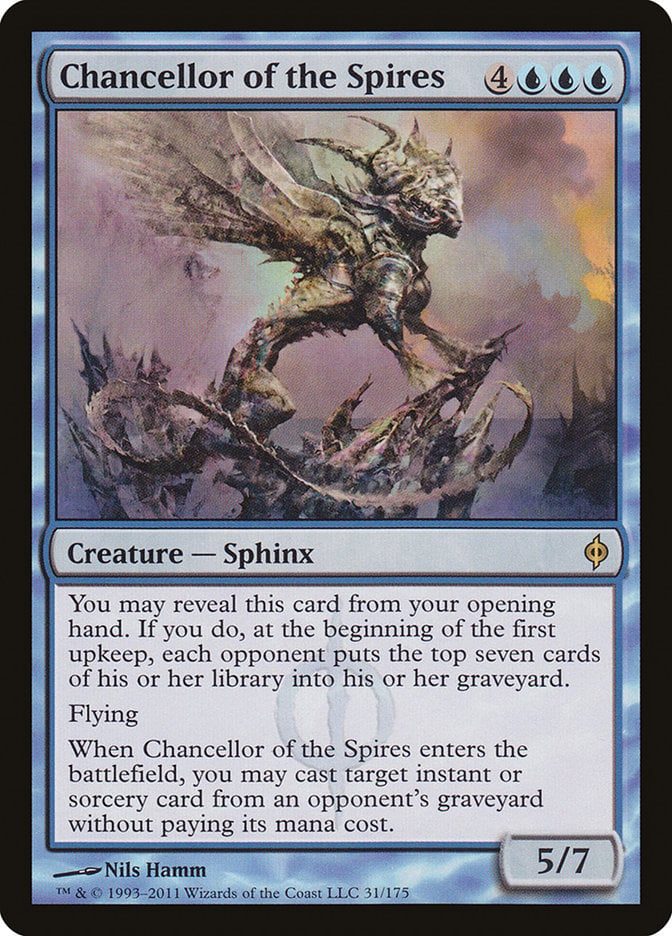
I’ll kick things off with Chancellor of the Spires, then. Chancellor is a costly creature, but the reason it’s on my shortlist is that it doesn’t exile the spell you are able to cast from its trigger. This means that, like in my earlier anecdote, you can keep using this spell as the game continues.
Casting an efficient removal or card draw spell multiple times for free (if you can flicker or otherwise trigger the Chancellor) can give you a solid advantage, and the fact that ramp and spells get better every year means this card does, too. While it’s not as big a tempo swing as Diluvian Primordial, it excels in other areas.
Dire Fleet Daredevil
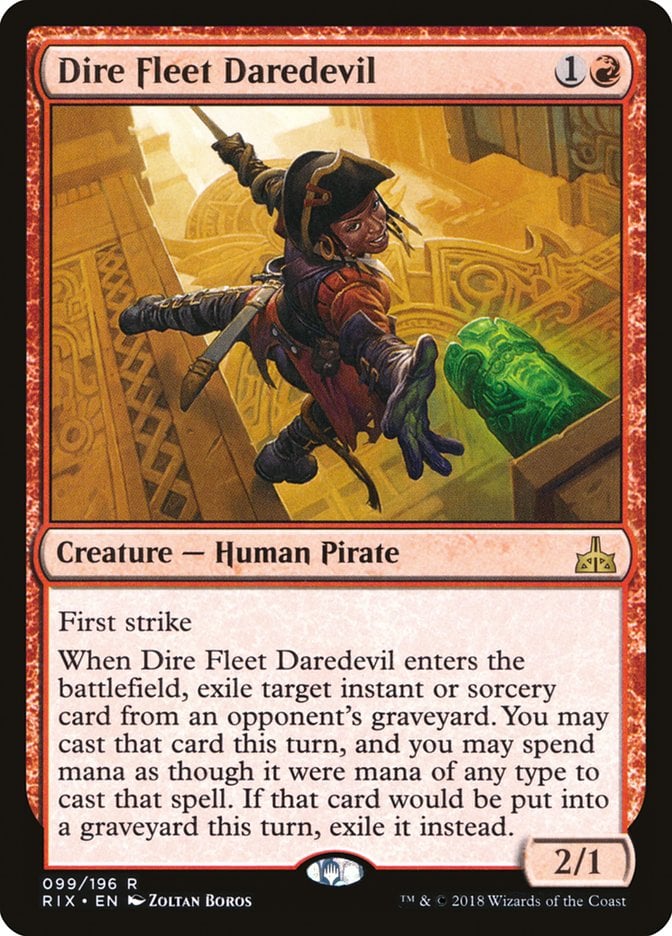
The next card is one that keeps sneaking into more and more of my decks, and I have a bit of a soft spot for it. Dire Fleet Daredevil–the ol’ “Snatchcaster Mage”–is a powerful piece of kit. For only two mana, you can cast an instant or sorcery in an opponent’s graveyard, and spend many as though it were any type to cast it. That spell is then exiled.
Essentially, this gives you access to any instant or sorcery in an opponent’s bin for a surcharge of one and one red mana. It’s a great deal, and it’s great because you can re-use this wily pirate as often as you can trigger the ETB.
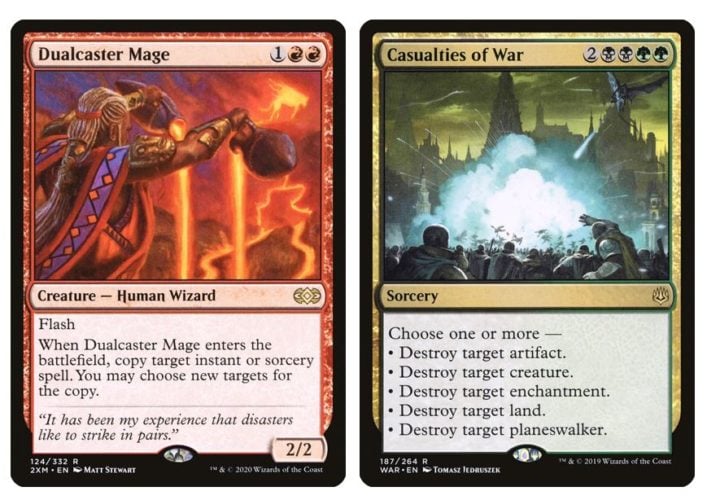
When combined with the likes of Dualcaster Mage for a one-two punch, you can do some truly disgusting things, like copying a Casualties of War only to cast it again the turn after.

The uses for this card are many, and though the ceiling is only ever as high as what your opponents are playing, the floor is solid: being able to re-cast a Swords to Plowshares or Cultivate as a red player is more than enough to make you happy. Just be prepared to hold it in your hand a while–I once played against three green decks and none of them ramped on turn three of four! I was gutted.
Dredge the Mire
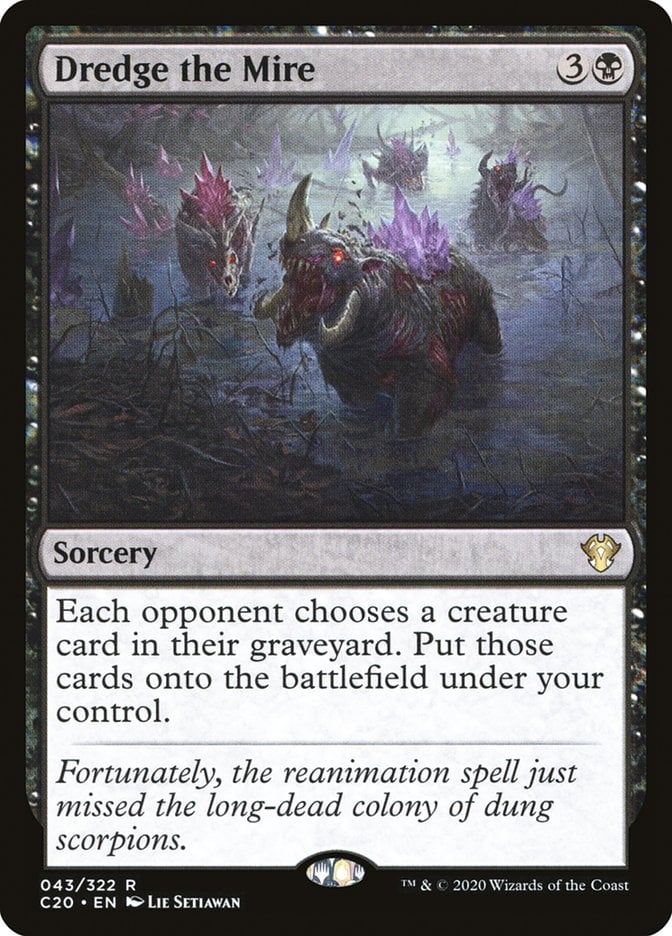
Dredge the Mire is criminally underplayed, and I’m not the first to point it out. It’s only posted in around seven hundred decks on EDHREC, and though it’s far from what you might call “optimized,” I feel like it’s worth a look.
What’s probably holding it back is that it firstly requires graveyards to have cards in them, and secondly that you’ll always get the worst option. That said, four mana for up to three creatures is a very good deal, and, like with Dire Fleet Daredevil, the floor is still pretty good.
Even if you don’t hit a haymaker, hitting a Sakura-Tribe Elder and a Magus of the Wheel, for example, is still pretty good. If you have an engine in play already, then hitting creatures at all is good — it doesn’t matter what they are if you’re going to sacrifice them for effects. I’ve been enjoying Hate Mirage for similar reasons — just copying two value creatures can be good enough, but the ceiling on both these cards is much, much higher.
Memory Plunder
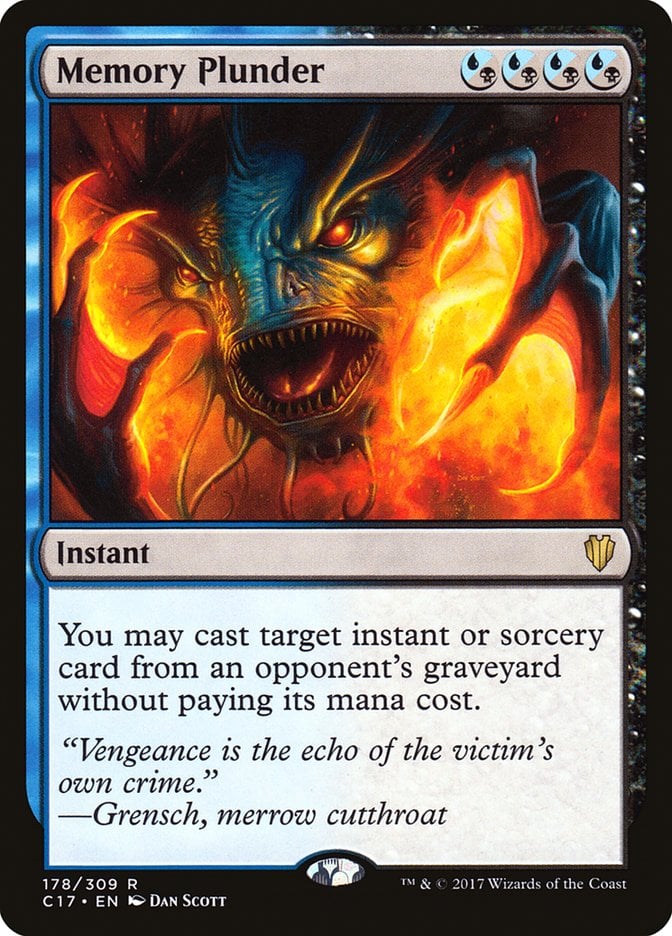
With the Sneak Attack Dimir rogues precon proving popular, many Dimir-based graveyard interactions are finding themselves in the limelight once more. One such card is Memory Plunder.
Memory Plunder grants you the ability to cast an instant or sorcery from an opponent’s graveyard at instant speed. This does ignore the timing restriction if you wish to copy a sorcery, but it cannot ignore any other restrictions — for example, a card that says “cast this spell only during combat” would still not be able to be cast outside of the combat step.
For the most part, Memory Plunder acts as a four-mana wildcard. It could be a board wipe, a removal spell, card draw, ramp, or even a counterspell. The flexibility is great, but holding four mana up for interaction is admittedly easier at more casual tables, which probably accounts for why this card doesn’t show up very often.
If you have ways to mill your opponents, Memory Plunder gets better and better, and in general, I feel like most Dimir decks should be finding room for this spell. Covetous Urge is a similarly underplayed spell, but one that is firmly in the camp of hard to resolve on webcam, so I can’t honestly recommend that one.
Necromantic Selection
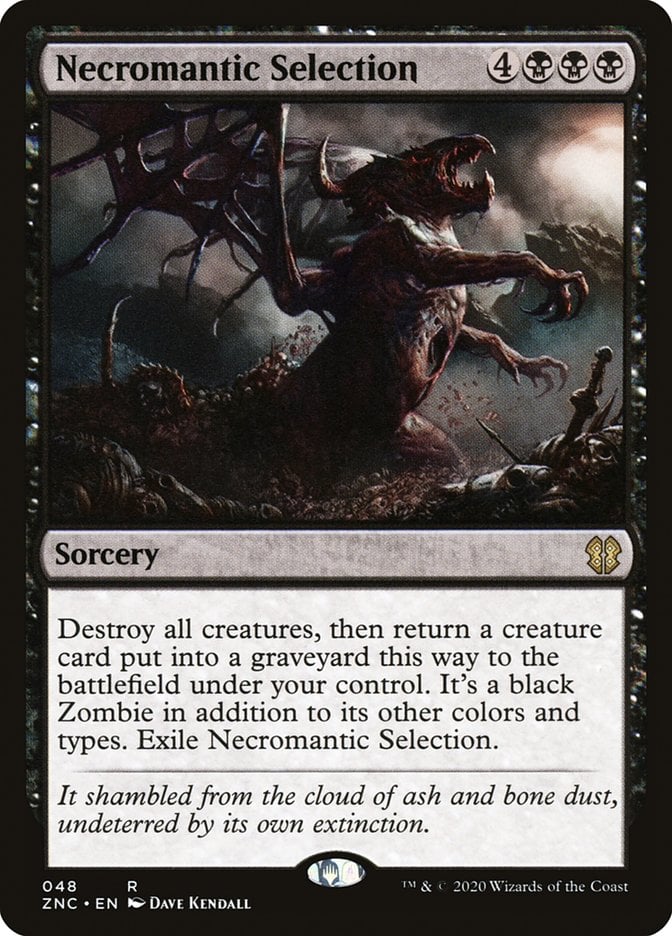
In June, the rules around what happens to Commanders when they die were changed. They now visit the graveyard and trigger “dies” effects before their owner gets to decide where they will end up.
In short, this means commanders like Elenda, the Dusk Rose were now viable, and for the most part, the change did little else to change up how games are played.
One card, however, benefits from this change — Necromantic Selection. Because commanders now go to the graveyard when they die, they are eligible for selection. This works because state-based actions are not checked until the spell has resolved, and so there is no opportunity for the owner of the commander that was destroyed to then send that commander back to the Command Zone — their first opportunity to do so is after the spell resolves.
This makes Necromantic Selection more potent. It was always pretty decent, but in a format where more and more haymakers and must-answer creatures are printed every set, having the ability to wipe the board and pick the best of the bunch can be game-winning. Adding on the ability to steal a commander? Well damn, this card just got a lot more exciting. Sometimes taking a commander away is enough to nullify a win condition, and that’s a powerful play.
Skullwinder
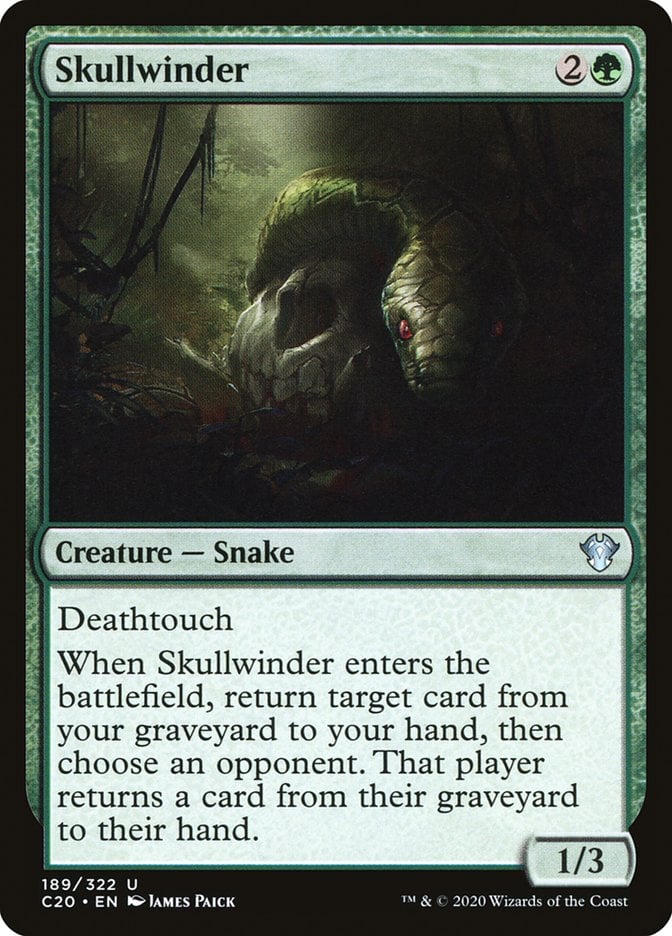
If you like a little more politics in your games, then consider leaving your Eternal Witness at home. Skullwinder can do roughly the same thing, except it also gives an opponent a card back, too. This is, for all intents and purposes, worse than Eternal Witness — except where it’s better.
Giving an opponent a card can sometimes leave you in a situation where there’s no good choice, but more often that not, giving the player who is a little behind a helping hand can pay dividends later in the game. Whether you ask them to take a particular removal spell to help deal with a threat, or you give them the opportunity to ramp or draw some cards to get back into the game, it’s generally a deal you’ll be glad to make.
There’s also the fact that you get a deathtouch body out of the deal. Deathtouch is pretty useful, all things considered, and when you can play Khalni Ambush//Khalni Territory in your mana base? Well, sometimes you just get a removal spell in installments.
Pulsemage Advocate

Now, if you really love politics, then let’s kick it up another notch. Pulsemage Advocate asks a lot in exchange for helping you out. Being able to tap to reanimate a creature in your graveyard is very powerful, but it costs you giving an opponent three cards from their graveyard back to hand.
The reason this card sees little play is obvious — how many times is this ability going to be incredibly risky to resolve? But, like Skullwinder, there will be many board states in which you can operate fairly freely in order to get what you want. As you get to target the cards they receive back, you can be as generous or as miserly as you like.
Pulsemage Advocate gets better when you’re playing against decks that put a lot of their own cards into the graveyard, anyway, like self-mill or lands-based decks, or when you have wheel effects in your deck. It’s not the best card, but I do think it’s worth a look.
Grim Return
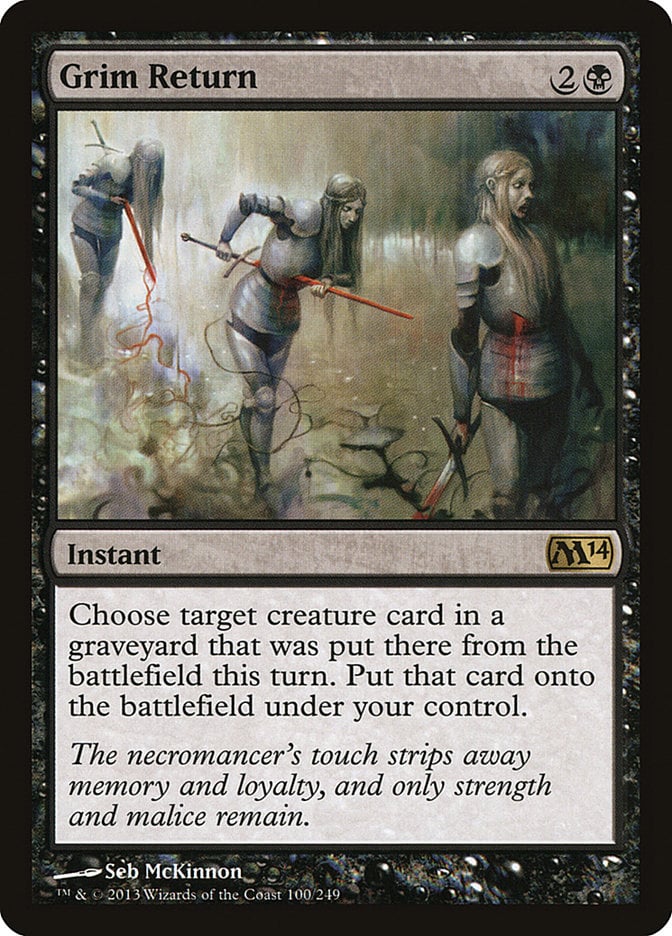
I could start and finish this section by simply stating this card has Seb McKinnon art. Honestly? That’s enough of a reason to get me to play a lot of cards.
When Minion’s Return was previewed at the start of the year, many people got excited about the opportunity to effectively steal creatures with it. I’ll admit I was sucked in a little, too, and it took me a moment to realize that a better option already exists.
Minion’s Return asks that you use it preemptively, which means that any further sorcery-speed interaction during the turn might foil your plan. Instead, by playing Grim Return, you get a chance to cast it during the end step, avoiding some of the pitfalls of casting it too soon.
While Thrilling Encore is technically a lot stronger for a little more mana, that card is a known quantity at this point, and isn’t really underplayed. Grim Return gives you a single-use Thrilling Encore for a much more achievable three mana, and that’s a lot easier to hold up.
Reanimate
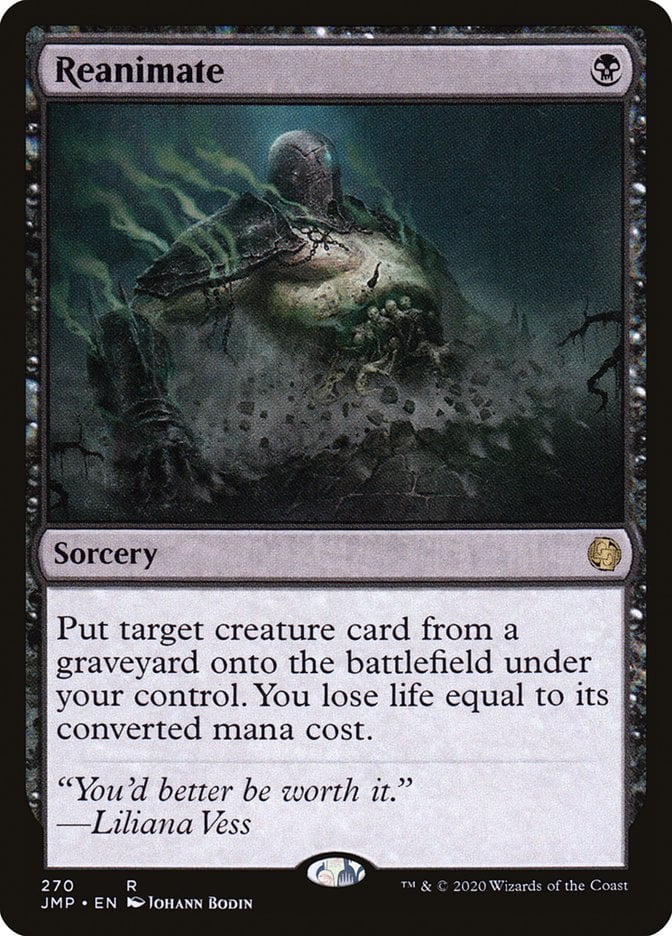
It might seem odd for me to recommend Reanimate here, especially as it’s played in a solid 10% of decks on EDHREC. The reason I’m recommending it is that I feel like it’s just a staple black card, whether you’re in a reanimator build or not.
More people need to play this card outside of reanimator, because it’s just that good. I first cottoned on to how useful this card could be when I built Syr Gwyn, Hero of Ashvale last year. Having access to a one-mana way to recur my six-mana commander was invaluable, and helped the deck function as a Voltron deck a lot better.
More than that, though, it offers you the ability to plunder an opponent’s graveyard for whatever is most useful at the time for an incredibly low price. One mana plus some life is easily achievable in Commander, and I truly feel like this card should just be in most decks that play or splash black. What’s more, the Jumpstart reprint probably brings this card down to the cheapest it’ll be for some time. You should probably pick one up.
There are a bunch of cool recursion cards in this article, and I’ve tried them all out in different builds recently and really enjoyed playing with them. Recursion shouldn’t only be focused on your own graveyard, and once you consider the opportunities available, you might stumble upon some really cool interactions.
Plenty of cards didn’t make it into the article today: Spelltwine; Dimir Doppelganger; even Shaman’s Trance, which can be pretty cute in Chainer. Hit me up on Twitter and let me know what you enjoy playing to take advantage of your opponent’s graveyards.

Kristen is Card Kingdom’s Head Writer and a member of the Commander Format Panel. Formerly a competitive Pokémon TCG grinder, she has been playing Magic since Shadows Over Innistrad, which in her opinion, was a great set to start with. When she’s not taking names with Equipment and Aggro strategies in Commander, she loves to play any form of Limited.

